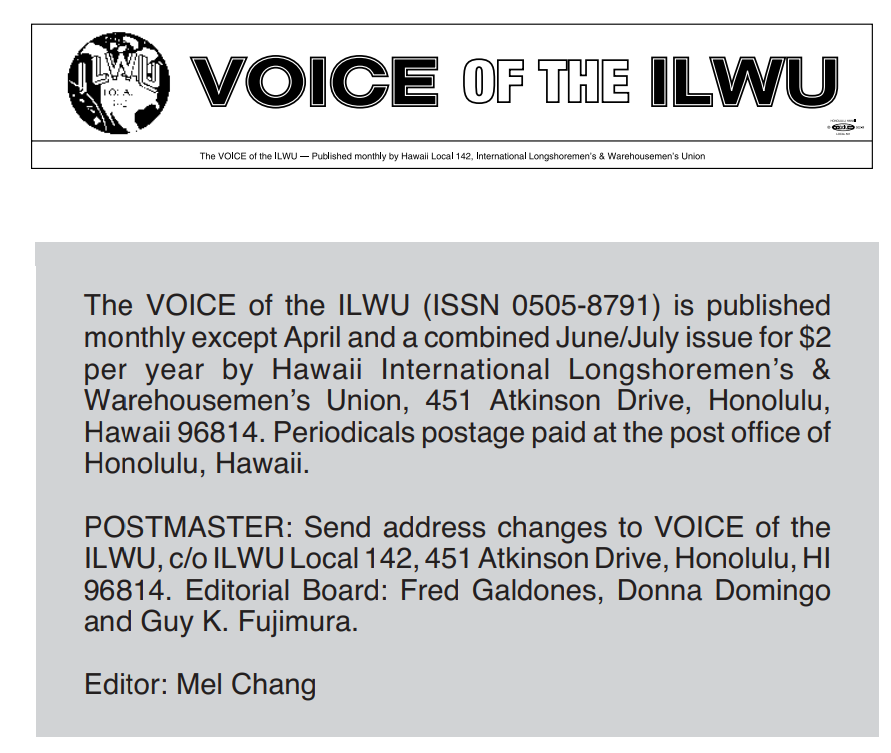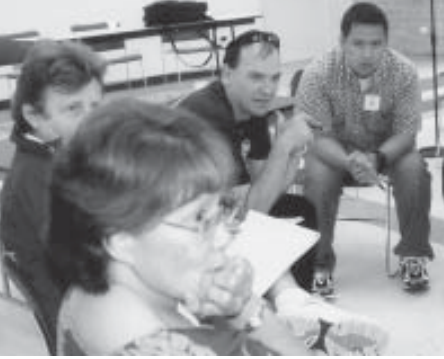HONOLULU—Before Hawaii Local 142 did its training, Alex Torres thought organizing was for professionals. “I always thought it was only the organizing department that does organizing,” said Torres, who works at the Dole Plantation Store on Oahu and helped bring it into Local 142. “Here I learned that it’s about everyone getting involved,” he said.

The June 4-7 workshop brought 53 rank-and-file activists together with 25 of the local’s full-time elected officers and the ILWU International organizing staff. The Hawaii participants represented the full diversity of Local 142, with people from Oahu, the Big Island (Hawaii), Maui, Kauai and Lanai who worked in agriculture, tourism, general trades, the longshore division and the Inlandboatmen’s Union (IBU).
“We wanted to put together a training with the national AFL-CIO’s top trainers to show us what we can do to move forward not only in Hawaii but on the mainland too,” said ILWU International Vice President Wesley Furtado. National AFL-CIO Organizing Director Stewart Acuff, Organizing Institute Director Sam Luebke and Director of Strategic Research Ken Zinn led the Thursday and Friday sessions, with Alison Reardon presenting on the Employee Free Choice Act Saturday morning. Over the two and a half days participants absorbed a brain-splitting amount of information and practiced the fundamentals of targeting and outreach.
Need to organize
Workers’ declining power in politics and on the job make organizing imperative, said Jonathan “Lono” Kane, IBU Regional Director for Hawaii. “We’re in the fight of our lives. If we don’t get together, those guys-the employers and their politicians-are going to have our lunch,” he said.
Union density, the percentage of unionized workers, has fallen sharply over the last 50 years. Now only one U.S. worker in eight belongs to a union, compared to more than one in three in 1955. When you take public workers out of the picture, it gets even gloomier. Fewer than one in ten private-sector workers have union representation.

Though Hawaii does better, with nearly one in four workers belonging to unions, it has lost density over the last 20 years. Shrinking numbers equal shrinking power, said Local 142 President Fred Galdones. “People listen to numbers,” said Galdones. “Employers have fear when they see a mass group of employees united. They have respect for that organization. Politicians will listen to us when they see the vast group of people we represent.” Galdones challenged the local to develop an organizing team and strategy for growing the union by 10 percent.
Employer abuse
Dwindling union membership testifies to the erosion of workers’ rights, Acuff said.
“American workers have lost the right to organize,” he said. He and the other presenters offered studies and statistics proving the point. Some 20,000 workers got fired last year for trying to organize, even though that’s illegal. During organizing drives more than 90 percent of employers force people to attend mass anti-union meetings on work time. About threefourths haul people in for one-on-one sessions, and about half predict the shop will have to close if the union comes in, though that’s illegal too.
Just to show the pull of the antiunion spiel, Sam Luebke put participants through a mock-antiunion meeting à la Wal-Mart. Imagine how odd it was to walk into a room full of Local 142 members and hear them chanting, “Give me a ‘W’… Give me an “A’ . . . ”
The drawn-out timeline for NLRBsupervised elections allows for all these abuses. To better the odds of winning a union, the AFL-CIO advocates a change in the law as well as a change of strategy. The Employee Free Choice Act would make card checks the standard way of getting union representation. But unions have already scored major wins with strategic organizing, using the leverage they have in bargaining to persuade employers to agree to cardcheck at non-union plants.
New strategies
For example, UAW members bargaining with Daimler-Chrysler got a card-check neutrality agreement at two unorganized Freightliner plants in rural North Carolina. The employer agreed not to campaign against the union and recognize the UAW if a majority of the workers signed cards. In one week in February 2003, the union signed more than half the 3,100 Freightliner workers.
Bringing on Freightliner made sense to the UAW because it helped boost the union density in their industry, and that helped build power. “You don’t build power one workplace at a time,” Ken Zinn said. “Where and who you organize matters.” With Peter Olney of the University of California’s Institute on Labor and Employment, Zinn walked participants through the fundamentals of strategic targeting.
Strategic targets may be non-union competitors of unionized companies, or related businesses, like the golf courses belonging to a union hotel, or new types of companies, like the wireless subsidiaries of traditional phone companies. A good target also has pressure points. Perhaps the union can appeal to users of its services, expose its failure to comply with labor and environmental regulation or intervene when it needs government permits-while workers put the heat on from the inside.
Plan for Hawaii
“This is basic, fundamental ILWU stuff,” said Local 142 SecretaryTreasurer Guy Fujimura. The union targeted hotels as an emerging industry on Maui in the 1960s and again in the late ’70s and early ’80s during the hotel boom fueled by Japanese capital. It used its political power and community support to get neutrality agreements and then win contracts.
Given the rapid changes in the cargo-moving industry, longshore needs to be concerned with organizing as well, said Local 142 Longshore Division BA Tyrone Tahara.
“We should have a bunch of longshoremen listening to this,” he said. “Our jobs will be protected if we help the guys on our flanks.” West Coast longshoremen had that same insight in the late 1930s when they began the “March Inland.” They organized the warehouse workers who handled the when it left the docks, turning potential scabs into powerful allies.
All the participants at the training had a chance to brainstorm strategic targets, working in small groups then sharing the results with everyone. Frank Chargualaf from the Renaissance Wailea Beach on Maui kicked off the presentation for the first group. “Forgive me, I’m shy, but I think we’re all in the same boat here,” he said. “Amen!” someone replied from the crowd, to general laughter.
That shyness got sorely tested when participants practiced house-calling. Many organizing drives are built on house calls, where the organizers and organizing committee members drop by workers’ homes unannounced to “talk union.”
“Organizing is one person talking to one person,” Luebke said. “But these are deeper and more serious conversations than selling aluminum siding. You’re dealing with deep hopes and fears, hopes for your future and your family’s.”
To make house calls work, you have to listen, listen and listen more, Luebke stressed. Local 142 staff roleplayed the targeted workers, and some of them played hard. Even more experienced participants noted that the clutch of nerves while opening the conversation was as real as the real thing.
But in the training, and real life, people realized they could do things they never thought possible.
“It’s brought me out of my shell,” said Leina Badiyo, who works at Hawaii Job Corps. “I know now I can talk to people.”
Carol Rayno, a soft-spoken former school teacher, never thought she could organize, even though she’s been unit secretary-treasurer at Young Brothers on Kauai for 18 years. “I always thought I couldn’t be an organizer because I wasn’t aggressive,” she said. “But you don’t have to be. You’re a listener, not a talker.” She also noted the need to apply the lessons of the training to internal organizing.
“We’ve got to begin from home, from within, so we have a larger resource,” she said.
Local 142 will never be able to meet its high goals for growth without this new resource, said Vice President Donna Domingo. “That’s how we grow, through our members. We believe in them. They get it. We just need to give them tools and encouragement.” ◆

(Above, l-r) Participants Frank Chargualaf and Lena Staton from the Renaissance Wailea Beach Resort, Maui; International Rep. Tracy Takano; Tessie Shinozawa from New Otani Kaimana Beach Hotel, Oahu; Simplecia Timosan from King Kamehameha’s Kona Beach Hotel and Gary Duguran from ML Macadamia Orchards - Kau.

The organizing training gave people from different islands and industries a chance to work together. (Front to back) Carol Rayno from Young Brothers Ltd., Dixie Youts from Renaissance Wailea Beach Resort, Ron Clough, Hawaii Division organizer, and Alex Torres from Dole Plantation Store.
